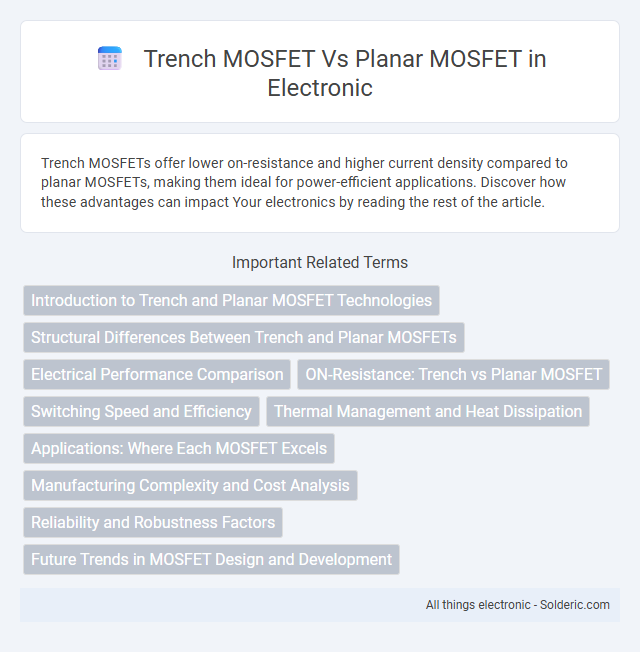Trench MOSFETs offer lower on-resistance and higher current density compared to planar MOSFETs, making them ideal for power-efficient applications. Discover how these advantages can impact Your electronics by reading the rest of the article.
Comparison Table
| Feature | Trench MOSFET | Planar MOSFET |
|---|---|---|
| Structure | Vertical trench gate in silicon substrate | Flat planar gate on silicon surface |
| On-Resistance (Rds(on)) | Lower due to vertical current flow | Higher due to lateral current flow |
| Switching Speed | Faster switching, lower gate charge | Slower switching, higher gate charge |
| Voltage Rating | Optimized for low to medium voltages (up to ~250V) | Better for high voltage applications |
| Manufacturing Complexity | More complex due to trench etching process | Less complex, well-established planar process |
| Package Density | Higher cell density allows compact designs | Lower cell density, larger die size |
| Cost | Potentially higher due to complex process | Generally lower manufacturing cost |
| Applications | DC-DC converters, power supplies, low voltage power switching | High voltage power control, general purpose switching |
Introduction to Trench and Planar MOSFET Technologies
Trench MOSFET technology features vertically oriented channels etched into the silicon substrate, enabling higher current density and lower on-resistance compared to traditional Planar MOSFETs, which have laterally diffused channels on the surface. This vertical structure in Trench MOSFETs reduces chip size and enhances switching speed, making them suitable for high-efficiency power applications. Planar MOSFETs remain widely used due to their simpler manufacturing process and cost-effectiveness in low-frequency and low-power circuits.
Structural Differences Between Trench and Planar MOSFETs
Trench MOSFETs feature vertical channels etched deep into the silicon substrate, enabling higher cell density and reduced on-resistance compared to the planar design, where channels lie flat on the surface. The trench structure provides better gate control and improved current flow efficiency due to its three-dimensional architecture, enhancing performance in power applications. Your choice between these MOSFET types depends on balancing fabrication complexity with the need for compact, high-efficiency power devices.
Electrical Performance Comparison
Trench MOSFETs exhibit superior electrical performance compared to Planar MOSFETs due to their lower on-resistance (R_DS(on)) and higher current density, which results from the vertical channel design and increased effective channel width. Your power conversion efficiency improves with Trench MOSFETs because they reduce conduction and switching losses, making them ideal for high-frequency and high-efficiency applications. In contrast, Planar MOSFETs typically have higher gate charge and resistance, limiting their performance in advanced power systems.
ON-Resistance: Trench vs Planar MOSFET
Trench MOSFETs exhibit significantly lower ON-resistance (R_DS(on)) compared to Planar MOSFETs due to their vertical channel structure, which increases channel density and reduces current path length. The trench design enables a larger effective channel width per unit area, improving conductivity and energy efficiency in power applications. Planar MOSFETs typically have higher R_DS(on) because their horizontal channel limits scaling and increases overall conduction losses.
Switching Speed and Efficiency
Trench MOSFETs offer significantly faster switching speeds compared to Planar MOSFETs due to their vertical channel design, which reduces gate charge and on-resistance. Your power conversion systems can achieve higher efficiency with Trench MOSFETs, especially in high-frequency applications, as their lower parasitic capacitances minimize switching losses. Planar MOSFETs, while simpler in structure, generally exhibit slower switching speeds and higher conduction losses, making them less efficient for rapid switching scenarios.
Thermal Management and Heat Dissipation
Trench MOSFETs offer superior thermal management and heat dissipation compared to Planar MOSFETs due to their vertical structure, which enables lower on-resistance and reduced power loss. This design allows heat to spread more efficiently through the device, minimizing hotspot formation and enhancing reliability under high current conditions. Your power electronics system benefits from improved thermal performance, leading to longer device lifespan and better overall efficiency.
Applications: Where Each MOSFET Excels
Trench MOSFETs excel in high-efficiency power conversion applications such as DC-DC converters, power supplies, and electric vehicles, thanks to their low on-resistance and superior current handling. Planar MOSFETs are preferred in analog circuits, low-voltage switching, and microcontroller interfaces due to their robustness and simpler fabrication process. Each type offers distinct advantages aligning with specific performance requirements, influencing their suitability in power management and signal processing domains.
Manufacturing Complexity and Cost Analysis
Trench MOSFETs involve more intricate manufacturing processes due to the need for deep trench etching and advanced lithography, leading to higher production costs compared to Planar MOSFETs which utilize simpler surface-level diffusion techniques. The complexity of trench structures enhances device performance but requires precision equipment and longer fabrication times, increasing capital expenditure. Planar MOSFETs remain cost-effective for low to medium power applications due to their straightforward manufacturing steps and established production lines.
Reliability and Robustness Factors
Trench MOSFETs demonstrate superior reliability and robustness compared to Planar MOSFETs due to their vertical cell structure, which provides lower on-resistance and enhanced thermal dissipation. Planar MOSFETs often face challenges with higher electric field concentration at the gate edge, increasing susceptibility to breakdown and failure over time. You benefit from better longevity and performance stability with Trench MOSFETs, especially in high-current and high-temperature applications.
Future Trends in MOSFET Design and Development
Future trends in MOSFET design emphasize the increasing adoption of Trench MOSFETs due to their superior current density and reduced on-resistance compared to Planar MOSFETs, enabling enhanced efficiency in power electronics. Emerging developments include nanostructured semiconductor materials and advanced trench geometries that further improve switching speeds and thermal performance. Research focuses on integrating these innovations to meet the growing demands of electric vehicles, renewable energy systems, and high-frequency power converters.
Trench MOSFET vs Planar MOSFET Infographic

 solderic.com
solderic.com